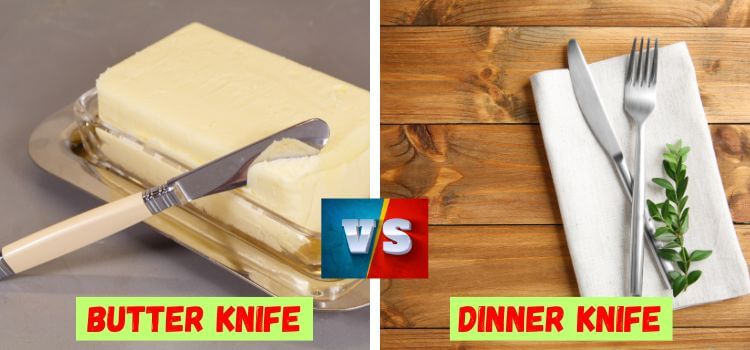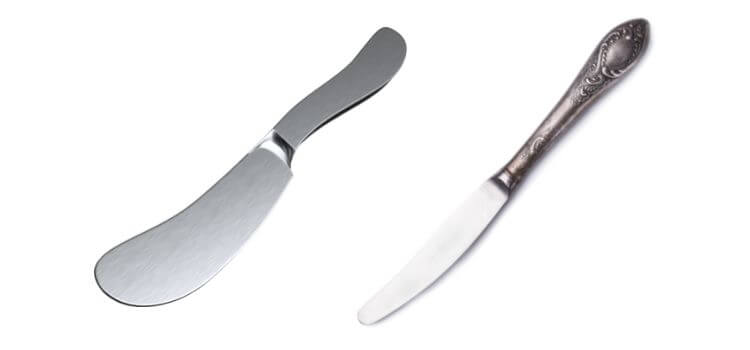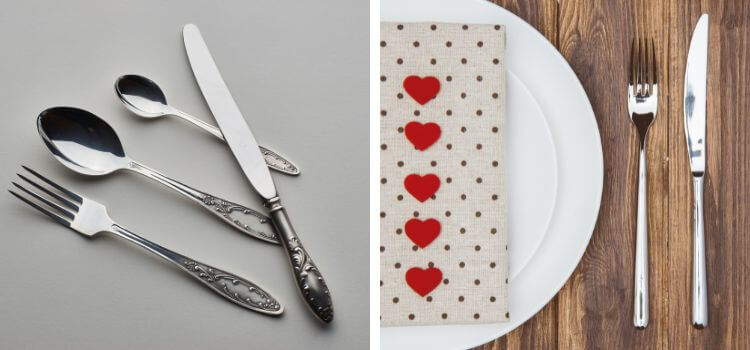As an Amazon Associate, I earn from qualifying purchases
In this Comprehensive guide, learn about the different traits and purposes that distinguish a butter knife from a dinner knife. Whether setting a formal table or cooking a casual dinner, knowing the Butter Knife vs Dinner Knife issue helps improve your eating experience. Explore the distinctions in design, size, handle, material, and more as we cut through the complexity of cutlery.

Features Comparions: Butter Knife vs Dinner Knife
Fortessa | Wine Things | Oneida | Winco | |
 |  |  |  | |
Lucca Faceted | Resin Spreader | Marquette | Lafayette Hollow | |
Butter Knife | Modern | Dinner Knives | Modern | |
Mirror Polished | Vino | Silver | Silver | |
0.15 Pounds | 7.8 ounces | 11.1 ounces | 2.05 ounces | |
6.79 x 0.83 x 0.36 inches | 5 inch L | 10.51 x 2.68 x 1.73 inches | 9.25 x 0.81 x 0.63 inches |
What is a Butter Knife?
A butter knife is an instrument to spread butter or other spreads over bread or other meals (such as jam, cream cheese, or peanut butter). A dull edge and a rounded recognized it or sometimes pointed tip.
Butter knives, unlike other knives, are not intended for cutting. Their form and lack of sharpness, on the other hand, make them perfect for spreading, which needs a smooth and controlled motion rather than slicing or chopping.
A butter knife is usually placed on the butter dish or horizontally across the bread plate in a formal table setting. Its design may alter depending on geographical and cultural variances, but the goal stays the same.
Characteristics Of Butter Knife
Dull Edge: Unlike most knives, butter knives have a dull edge. This makes them safe and less likely to cut the user or damage soft bread or pastries.
Rounded Point: The tip of a butter knife is usually rounded, reducing the risk of accidental injury.
Design: The design of a butter knife varies, but most are about the same length as a teaspoon. Some are flat and wide, while others are more narrow with a slight curve.
Material: For durability and longevity, butter knives are typically made from stainless steel. However, they can also be made from silver, plastic, or wood.
Versatility: Though intended for butter, these knives are often used to spread soft substances, such as cream cheese or jam. They can also be used to cut very soft foods.
Butter Knife Types
There are several sorts of butter knives, each with its purpose or stylistic preference:
Master Butter Knife: This is a giant butter knife often used by the host to cut and serve butter. Instead of different place settings, it is frequently stored alongside the serving dishes.
Individual Butter Knife: A regular butter knife seen in individual place settings. It’s intended for spreading butter or other spreads on bread and other dishes.
Butter Spreader: This instrument is intended primarily for spreading and often has a broader, rounded blade. While it is not often referred to as a “knife,” it provides a comparable function.
Silver Butter Knife: A more exquisite variation often used in formal dining. Typically, it is constructed of sterling silver or silver-plated metal.
French Butter Knife: The French butter knife, also known as a “sabre à beurre,” is distinguished by its unusual blade that is both wide and rounded. It may stand on its edge so the butter-laden blade does not contact the table.
Cheese and Butter Knife: This instrument spreads butter and cuts cheese. The blade may have smooth edges for spreading and serrated edges on the other for cutting.
What is the use of Butter Knife?
A butter knife is a cutlery that spreads butter or other soft spreads, such as jam or cream cheese, over bread or other baked items. Its dull edge and rounded tip make it safe and straightforward while protecting fragile pastries or bread.
Although primarily used for spreading, a butter knife may cut delicate items such as ripe fruits or cheeses. It may also cut any relatively easy or gentle dish, such as an omelette or pancake, in a more informal eating situation.
Also, the host may use a giant knife in formal dining to cut and distribute butter from a typical dish to individual guests’ plates. This is less typical in casual or regular eating settings.
Fortessa Lucca Faceted Solid Handle Butter Knife
The Fortessa Lucca Faceted 18/10 Stainless Steel Flatware Solid Handle Butter Knife Set offers exceptional style and function. This butter knife set 12 is masterfully made from strong gauge 18/10 stainless steel, assuring stain and corrosion resistance and an exceptional gloss.

Each knife has a 360-degree design that is appealing from every viewpoint. With a curved handle with a comfortable and balanced grip, the Lucca faceted design adds a distinctive, contemporary touch.
These knives provide an excellent combination of usefulness and style, with a sharply serrated blade and strong handles. They are machine washable and bring the refinement of professional-grade dinnerware to your home.
PROS
CONS
Wine Things 4-Piece Butter Spreader Knife
The Wine Things Vino Resin Cheese Spreaders can spice up your dining experience. This four-piece set is made with hand-painted resin handles that reflect several aspects of the wine and cheese experience: a grape, a Gouda cheese, a red wine bottle, and the word ‘Vino.’

The handles and the long-lasting stainless steel blades give a unique blend of whimsy and practicality. While intended mainly for spreading cheese, these knives may also be used as butter spreaders, making them a versatile addition to your dinnerware. It should be noted that they should only be hand cleaned to keep their brilliant colour and detail.
PROS
CONS
What is a Dinner Knife?
In Western eating environments, a dinner knife is a table knife. In contrast to sharper knives used in meal preparation, it often has a blunt edge and is used mainly for cutting and pressing food.
It’s worth noting that the design of the dinner knife varies considerably based on the cultural setting and the sort of meal served. Steak knives, for example, are often offered for dinners with meat that needs higher cutting power.
Characteristics Of A Dinner Knife
Sharpness: While dinner knives are sharper than butter knives, they are typically less sharp than kitchen or chef’s knives. Their edges are designed to cut through soft or moderately complex foods but not hard foods.
Design: Dinner knives typically have a long, slim design with a pointed tip. This design allows for precise cutting and ease of use.
Material: Most dinner knives are made from stainless steel, though they can also be made from silver, gold-plated metal, or even plastic in some disposable sets.
Size: Dinner knives are generally one of the most significant pieces in a cutlery set. Their size makes them suitable for cutting more oversized food items.
Weight: The weight of a dinner knife can vary significantly depending on its design and the material it’s made from. Heavier knives may be considered more durable or higher quality.
What is the use of a Dinner knife?
A dinner knife is a kind of silverware often used to chop and push food during a meal. Its principal use is to chop food into smaller, more manageable bite-sized pieces. This comprises many items: meat, seafood, vegetables, and side dishes.
A dinner knife may be used for more than just chopping at the dinner table. It may, for example, be used to push food onto a fork, which is especially useful in Western eating etiquette when the fork is held in one hand and the knife in the other.
It may also spread condiments or other spreads on bread or other dishes. However, a butter knife or spreader is usually preferred for this.
In a formal environment, the position of the dinner knife might also indicate to the waitstaff whether the diner has completed eating or is just stopping. Placement of the knife diagonally across the plate with the handle on the bottom suitable, for example, might signal that the diner has completed their meal.
Oneida Marquette Fine Flatware Dinner Knives
The Oneida Marquette Fine Flatware Dinner Knives will elevate your eating experience. These knives, which come in four sets, exemplify classic beauty and contemporary simplicity. They have a flared end and beautiful beading that gives your table settings a polished touch.

These knives, made from the best 18/10 stainless steel, provide durability and corrosion resistance. Each item is mirror-finished and has a satisfying weight, indicating high-quality artistry. These knives will satisfy and last a lifetime thanks to their traditional design and high-quality materials. They’re also dishwasher safe, which makes cleanup a snap.
PROS
CONS
Winco 12-Piece Lafayette Hollow Handle Dinner Knife Set
The Winco 12-Piece Lafayette Hollow, Handle Dinner Knife Set combines functionality and beauty. For almost 20 years, professionals have trusted Winco to bring the excellence of commercial cookware to their homes.

This set’s knives are made of heavyweight 18-0 stainless steel, which provides excellent durability and usefulness at an affordable price. The Lafayette design offers an exquisite accent to your table setting, while the satin finish lends a sophisticated touch. These knives have hollow handles for a secure grip and are now accessible to serious home cooks.
PROS
CONS
Proper Knife Placement
Knife placement is essential to a table arrangement, especially when etiquette and procedure are followed on formal dining occasions. The placement of knives and other silverware influences the table’s looks. It sends precise messages to other diners and service workers.
Butter Knife Placement
The butter knife is put on the butter plate, usually positioned at the top left of the dinner plate, in a formal dining setting. The butter knife’s blade should be angled inward toward the diner. It is rarely seen on a main dinner plate or cutlery set since it is mainly used for spreading butter on bread from the bread plate.
In a casual situation, the butter knife may be found alongside the butter dish on the table for shared usage, or it can be found in the cutlery tray for individual guests to use as required.
Dinner Knife Placement
The dinner knife is positioned directly to the right of the dinner plate in a formal table arrangement. The knife’s blade should be pointing inward towards the dinner plate, indicating that it is not in use or a “resting” posture. If more than one knife is used (such as a fish or steak knife), the dinner knife is put closest to the dinner plate, with the knives arranged in sequence of usage from the outside.
The restrictions may be eased in a less formal or informal situation, and the dinner knife is generally placed to the right of the dinner plate.
To indicate that you have completed your meal, lay the knife (and fork) diagonally across the dish, with the knife blade pointing inward.
Is Butter Knife and Dinner Knife Similler?

While a butter knife and a dinner knife have similarities, they are designed differently and serve different purposes. Here are some distinctions:
A butter knife has a dull edge and a rounded or occasionally pointed tip that is meant to aid in spreading butter or other spreads. On the other hand, a dinner knife often has a more pointed tip and a little sharper edge, although it is still blunter than a kitchen knife. Some dinner knives are serrated to aid in cutting particular kinds of food.
A butter knife’s principal use is to spread butter, jam, cream cheese, or similar spreads over bread or other meals. A dinner knife is often used to cut food items during a meal, although it is not meant to cut through complicated or challenging meals like a steak knife.
A dinner knife is usually positioned to the right of the plate in a formal dining setting. A butter knife, on the other hand, is often placed on the bread plate or across the butter dish.
In the final analysis, although they may look identical at first sight, the dinner knife and butter knife are intended for different purposes. They are only sometimes interchangeable in formal dining situations.
Butter Knife vs Dinner Knife: What’s the Difference?
Several aspects come into play when determining the knife’s Battle, including design, size, handle, material, quality, pricing, and even customer service when ordering.

The following is how these two styles of knives differ:
Design
A butter knife with a dull, rounded blade is often smaller and lighter in weight. It is not sharp since it is designed primarily for spreading soft stuff such as butter or jam.
Dinner knives are bigger and have a more pointed and sharper blade. They are intended to cut through various meals, including meat and vegetables, and force food onto the fork.
Size
Butter knives are typically shorter in length than dinner knives. They are designed to fit into tiny containers such as butter dishes.
Dinner knives are longer and can chop through bigger chunks of food.
Consider The Handle
The handles of butter knives are frequently thinner and lighter, making them easier to manage while spreading butter or other spreads.
Dinner knives often feature more oversized, heavier handles that give a strong hold while cutting meals.
Material
Both butter and dinner knives are commonly made of stainless steel, which is strong and corrosion-resistant. They may, however, be constructed of different materials such as metal, plastic, and, in rare circumstances, wood. The formality of the dining setting often determines the material used.
Quality
The quality of butter and dinner knives varies greatly depending on the brand, material, and artistry. Knives from higher-end brands may be more robust, balanced, and visually beautiful. The quality of a knife is determined by variables other than whether it is a butter knife or a dining knife.
Cost
The price of both sorts of knives varies greatly depending on criteria such as the material used, the brand, and the overall quality and design of the knife. Again, the kind of knife (butter or dinner) is only sometimes the most important price factor.
Customer Service
Customer assistance should be included when buying butter or dinner knives, particularly when ordering from a recognized manufacturer. This might include warranties, return policies, and customer service responsiveness. Like quality and price, the amount of customer assistance is more likely determined by the brand and less by whether the product is a butter knife or a dinner knife.
Best Way To Sharping Your Kitchen Knives
Read Now
Conclusion
To summarize the Butter Knife vs Dinner Knife contrast, it’s evident that, although they both serve the same aim of improving our eating experience, they also have distinct responsibilities and characteristics. A butter knife’s spreading ability and a dinner knife’s flexible cutting ability have their place on the dining table. With this understanding, you can use and enjoy these mealtime staples in new ways.
FAQs
A regular dinner knife is usually between 9 and 9.5 inches long. The size, however, might vary based on the style, manufacturer, and kind of food served.
A standard dinner knife is often called a “dinner knife.” Some people refer to it as a “table knife.” It’s a common cutlery item for cutting and pressing food during meals.
Yes, ripe fruits, soft cheeses, and spreads may all be sliced with a butter knife. Due to its dull edge, it is not intended to cut through more complex foods.
Yes, particularly with soft cakes, a butter knife may be used to cut the cake. Its wide, dull blade slices the cake effortlessly without compromising the texture.
Dinner knives are less sharp than kitchen knives since they are meant for use at the dinner table, where safety is paramount. Their relative dullness protects against damage while allowing them to cut through softer or cooked meals.
Leave a Reply